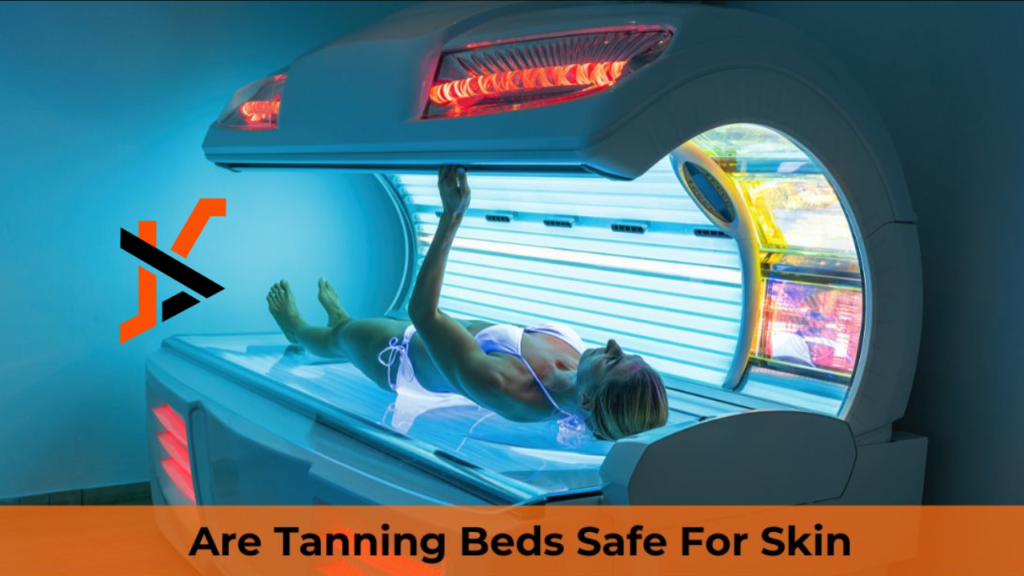Tanning beds have become famous for achieving a sun-kissed glow, especially when natural sunlight is limited. However, questions persist regarding their safety and whether tanning beds are safe for the skin.
In this article, we delve into the mechanics of tanning beds, exploring how they work and addressing the safety concerns associated with their use. Are tanning beds safe for the skin? Let’s find out.
Understanding Tanning Beds: How Do They Work
Tanning beds emit UV radiation, simulating the sun’s rays. They use bulbs that emit UVA and UVB rays. UVA penetrates deeper, while UVB affects the outer layers. UV exposure triggers melanin production, a pigment that defends against damage. Melanocytes increase melanin production, resulting in a darker tan.
Potential Risks Associated with Tanning Beds
Tanning beds expose users to ultraviolet (UV) radiation, which can lead to various health risks:
- Increased risk of skin cancer: UV radiation from tanning beds is linked to melanoma, basal cell carcinoma, and squamous cell carcinoma.
- Premature ageing: UV exposure can cause wrinkles, age spots, and loss of skin elasticity.
- Eye damage: Without proper eye protection, tanning bed use can lead to cataracts and corneal sunburn.
Regulation and Guidelines for Tanning Bed Usage
To mitigate risks, regulatory measures and guidelines are in place:
- Operational regulations: Many countries have laws governing tanning facilities, including limits on exposure time and age restrictions.
- Safety standards: Tanning beds must meet specific safety standards, such as providing protective eyewear and maintaining UV emission levels within acceptable limits.
- Public health campaigns: Education initiatives raise awareness about the dangers of indoor tanning and promote safer alternatives, like self-tanning products.
- Healthcare provider recommendations: Medical professionals advise against tanning bed use and advocate for sun-safe practices.
Alternatives to Tanning Beds for a Safe Glow
Instead of tanning beds, consider these safer alternatives to achieve a sun-kissed look:
- Self-tanning products: Use lotions, sprays, or mousses containing dihydroxyacetone (DHA), a colourless chemical that interacts with amino acids in the skin to produce a temporary tan. These products provide a natural-looking tan without exposure to UV radiation.
- Bronzing makeup: Apply bronzer or tinted moisturizers to enhance your complexion and create a sun-kissed glow. These products offer instant results and can be easily removed with makeup remover.
- Gradual tanners: Choose moisturizers or body lotions with built-in self-tanners for a subtle, gradual tan. These products allow you to control the intensity of your tan and moisturize your skin simultaneously.
- Sunless tanning booths: Visit a professional salon offering sunless booths or airbrush tanning services. Trained technicians apply a fine mist of self-tanning solution to your skin, ensuring an even and natural-looking tan.
- Natural sun exposure: Enjoy limited time outdoors in the early morning or late afternoon when UV radiation is less intense. Apply sunscreen with a high SPF to protect your skin from harmful UV rays and minimize the risk of sunburn and skin damage.
- Protective clothing: Wear clothing with UPF (Ultraviolet Protection Factor) to shield your skin from UV radiation while outdoors. Wide-brimmed hats, sunglasses, and long-sleeved shirts offer additional protection against sun exposure.
- Seek professional advice: Consult a dermatologist or skincare specialist for personalized recommendations on safe tanning practices and skincare products suitable for your skin type.
Are Tanning Beds Safe in Moderation?
Tanning beds are not safe, even in moderation, due to the following reasons:
- Increased risk of skin cancer.
- Premature ageing of the skin.
- Eye damage, including cataracts.
- Risk of addiction to tanning.
- Harmful UV radiation exposure.
- Higher risk of melanoma.
- Damage to skin cells’ DNA.
- Long-term health consequences.
- Lack of regulation in some areas.
- Safer alternatives, like self-tanning products, are available.
Do Sunbeds Damage Your Skin?
Yes, sunbeds can damage your skin. They emit ultraviolet (UV) radiation, which penetrates the skin and can lead to various health issues, including an increased risk of skin cancer, premature ageing, and eye damage.
How Can I Protect My Skin in a Tanning Bed?
To protect your skin while using a tanning bed, consider the following precautions:
- Use protective eyewear to shield your eyes from UV radiation.
- Limit your tanning sessions and avoid excessive exposure.
- Apply a broad-spectrum sunscreen with a high SPF to areas not covered by clothing.
- Moisturize your skin before and after tanning to help maintain its hydration and elasticity.
- Consider using a timer to monitor your exposure time and prevent overexposure.
Can You Tan Without Damaging Your Skin?
Yes, you can achieve a tan without damaging your skin by opting for safer alternatives to sunbeds, such as:
- Self-tanning products: Use lotions, sprays, or mousses containing dihydroxyacetone (DHA) to achieve a tan without UV exposure.
- Bronzing makeup: Apply bronzer or tinted moisturizers to give your skin a sun-kissed glow without sun exposure.
- Gradual tanners: Use moisturizers or body lotions with built-in self-tanners for a subtle, gradual tan that won’t harm your skin.
- Professional sunless tanning services: Visit a salon offering airbrush tanning or sunless tanning booths for a safe and even tan without UV radiation.
Conclusion
In conclusion, using tanning beds poses significant risks to skin health. Despite their popularity for achieving a sun-kissed glow, tanning beds emit ultraviolet (UV) radiation, which can lead to skin cancer, premature ageing, and eye damage.
While some may believe that moderate use of tanning beds is safe, the evidence suggests otherwise. Safer alternatives, such as self-tanning products and professional sunless tanning services, offer a way to achieve a tan without exposing the skin to harmful UV radiation.
Therefore, it’s essential to prioritize skin health and avoid using tanning beds altogether. Are tanning beds safe for the skin? The consensus among health experts is clear: No, they are not.

